Carnival Decoration
What Do People Eat During Carnival in Brazil?

During Carnival in Brazil, culinary delights emerge like colorful confetti, providing a sensory feast. The tempting selection of traditional dishes and street food showcases the lively essence of the celebrations, with each bite being a party in its own right.
From hearty black bean stew to crispy fried pastries with various fillings, the culinary landscape of Carnival in Brazil is as diverse and captivating as the parade itself.
But what exactly makes these dishes so special, and how do they intertwine with the cultural tapestry of this iconic event?
Key Takeaways
- Acarajé is a beloved carnival dish in Brazil, symbolizing cultural heritage and celebration, and is made from deep-fried black-eyed pea fritters with various fillings.
- Moqueca, a flavorful Brazilian fish stew, reflects diverse cultural influences and cooking techniques, and incorporates ingredients such as fish, coconut milk, palm oil, tomatoes, peppers, and lime juice.
- Brigadeiro, a decadent chocolate truffle, is a popular Brazilian sweet treat associated with joy, celebration, and togetherness, and is commonly enjoyed during Carnival and other festive occasions.
- Churrasco, a Brazilian barbecue tradition, is a cornerstone of the country's culinary heritage, featuring a variety of grilled meats cooked over open flames with traditional marinades including garlic, lime, and herbs.
Feijoada: A Hearty Black Bean Stew
Exploring Brazilian cuisine, you can't miss savoring Feijoada, a hearty black bean stew that has been a staple of Brazilian culinary tradition for centuries. This iconic dish is a symbol of the country's diverse cultural heritage, combining influences from Portuguese, African, and indigenous culinary traditions. Feijoada isn't just a meal; it represents a cultural celebration on a plate.
The dish typically consists of black beans, pork or beef, and a variety of smoked meats, slow-cooked to perfection with onions, garlic, and spices, resulting in a rich and flavorful stew. Feijoada is often enjoyed with traditional accompaniments such as white rice, collard greens, and farofa, a toasted cassava flour mixture. The combination of textures and flavors creates a harmonious dining experience.
As for beverages, pairing feijoada with caipirinha, a Brazilian cocktail made with sugarcane liquor, lime, and sugar, or a refreshing glass of chilled coconut water, complements the dish exceptionally well. Across different regions of Brazil, feijoada takes on unique regional variations. In Rio de Janeiro, feijoada is often served with orange slices to cut through the richness of the stew, while in Bahia, it may include seafood alongside the traditional pork and beans. These regional adaptations showcase the diverse culinary landscape of Brazil, adding depth and richness to the feijoada experience.
Coxinha: Savory Fried Chicken Croquettes
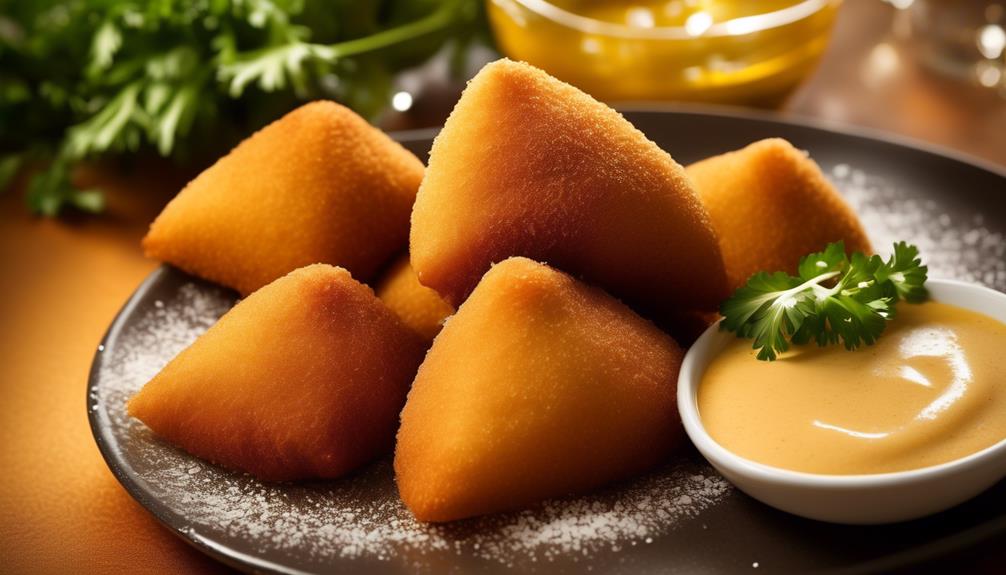
We love Coxinha, the savory fried chicken croquettes that are a beloved Brazilian snack.
The traditional recipe for Coxinha involves shredded chicken, onions, and a creamy filling, all encased in a dough, breaded, and fried to golden perfection.
Over the years, Coxinha has evolved into different flavor variations, with fillings like cheese, ham, or even shrimp, offering a delightful twist to this classic Brazilian treat.
Coxinha's Traditional Recipe
With its golden, crispy exterior and flavorful, creamy chicken filling, Coxinha stands as a cherished culinary delight deeply rooted in Brazilian tradition, often enjoyed during festive occasions like Carnival.
The history of Coxinha dates back to the 19th century, with its name derived from the Portuguese word for 'little thigh,' resembling the shape of the snack. Its cultural significance goes beyond being a popular street food, as it represents the fusion of indigenous, African, and Portuguese culinary influences in Brazilian gastronomy.
To prepare this iconic dish, shredded chicken is sautéed with onions, herbs, and spices, then enveloped in a velvety dough made from a mixture of flour and chicken broth. The Coxinha is shaped into teardrop forms, coated in breadcrumbs, and deep-fried to perfection.
This meticulous process ensures that every bite encapsulates the rich history and flavors of Brazil.
Coxinha's Flavor Variations
Savoring the diverse culinary landscape of Brazil, one encounters an array of enticing Coxinha flavor variations, each offering a unique twist to the classic savory fried chicken croquette.
Across different regions of Brazil, Coxinha takes on various regional variations, influenced by local ingredients and cooking traditions. In the northeastern region, Coxinha is often infused with a hint of malagueta pepper, adding a spicy kick to the filling.
In the Amazon, Coxinha may feature indigenous spices and herbs, showcasing the rich culinary heritage of the area. Moreover, modern twists on Coxinha have emerged, with some chefs experimenting with fillings such as shrimp, cheese, or even vegetarian options like hearts of palm.
These contemporary interpretations add an innovative touch to the traditional snack, appealing to a diverse range of palates while honoring Brazil's culinary history.
Coxinha's Serving Suggestions
Exploring the diverse culinary landscape of Brazil, one encounters not only a variety of Coxinha flavor variations but also a range of serving suggestions that elevate the experience of savoring these savory fried chicken croquettes.
Coxinhas are often served as appetizers at social gatherings, and their presentation is an art form in itself. When it comes to serving presentation, Coxinhas are often arranged on elegant platters, sometimes accompanied by vibrant, fresh garnishes such as parsley or lime wedges that add a pop of color to the dish.
Additionally, these delectable croquettes are often paired with complementary flavors such as hot sauce, aioli, or a zesty vinaigrette to enhance the savory goodness of the crispy exterior and the juicy, flavorful chicken filling.
These serving suggestions beautifully complement the Coxinha, creating an experience that tantalizes the taste buds and celebrates Brazilian culinary tradition.
Acarajé: Deep-Fried Black-Eyed Pea Fritters
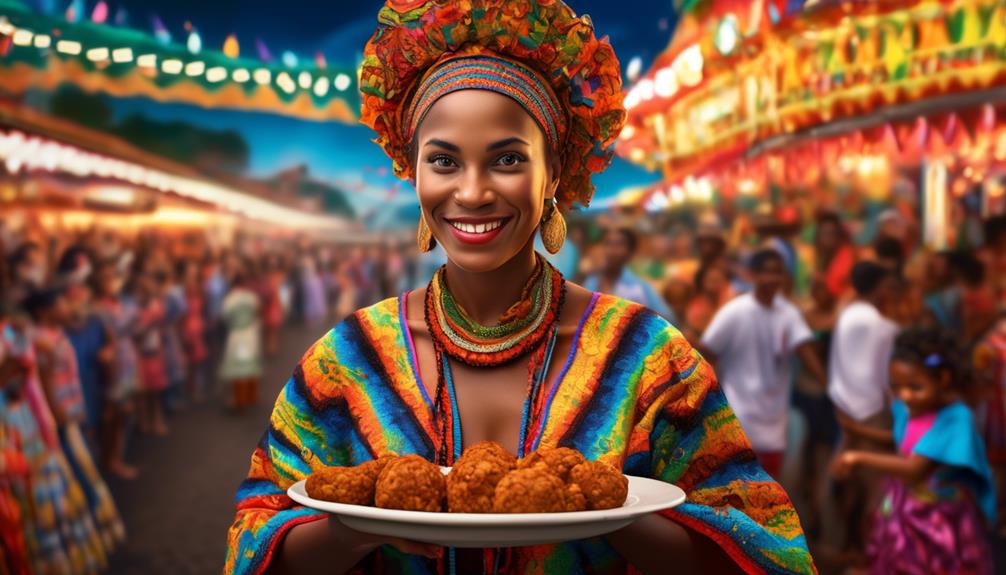
Acarajé, a beloved traditional Brazilian street food, holds a special place in our hearts and stomachs. Made from black-eyed peas and deep-fried to perfection, these fritters aren't just a snack but a cultural experience.
The ingredients and preparation of acarajé are steeped in historical significance, reflecting the rich culinary heritage of Brazil.
Traditional Brazilian Street Food
How are deep-fried black-eyed pea fritters, known as Acarajé, deeply rooted in the traditional Brazilian street food culture? Acarajé is a staple of Brazilian culinary traditions, especially during festivals and street fairs. These savory fritters have a rich historical significance, originating from the Afro-Brazilian culture in the northeastern state of Bahia. The dish is a delicious blend of black-eyed peas, onions, and salt, fried in palm oil until crispy. Acarajé is often split and filled with spicy shrimp, vatapá (a creamy paste made from bread, shrimp, coconut milk, and peanuts), and caruru (okra, onion, and shrimp sauce). This iconic street food not only represents the fusion of African, Indigenous, and Portuguese influences but also serves as a symbol of cultural heritage and celebration in Brazil.
| Acarajé | Origin | Ingredients |
|---|---|---|
| Savory | Bahia, Brazil | Black-eyed peas, onions, palm oil |
Ingredients and Preparation
Deep-fried black-eyed pea fritters, a beloved dish deeply rooted in Brazilian culinary traditions, bring together a rich blend of African, Indigenous, and Portuguese influences, symbolizing cultural heritage and celebration in Brazil.
The traditional acarajé recipe includes black-eyed peas, onions, and salt, all blended into a thick batter and then deep-fried in dende oil, a bright orange palm oil that gives the fritters their characteristic color and flavor. The technique of shaping the batter into small balls before frying is an art form in itself, requiring skill and precision.
Regional variations and influences can be seen in the different fillings and accompaniments, such as vatapá, caruru, shrimp, and hot pepper sauce, reflecting the diverse culinary landscape of Brazil.
The preparation of acarajé isn't just a cooking process but an expression of cultural identity and tradition, making it a quintessential dish during Carnival and beyond.
Cultural Significance
A symbol of cultural heritage and celebration, the deep-fried black-eyed pea fritters known as acarajé embody the rich blend of African, Indigenous, and Portuguese influences deeply rooted in Brazilian culinary traditions.
These fritters hold great cultural significance, particularly during festive celebrations like Carnival.
Acarajé is a product of the Afro-Brazilian heritage, specifically linked to the Yoruba culture and the deity Iansã, making it a significant part of Bahian cultural traditions.
Historically, acarajé was sold by Baiana women, who played a crucial role in preserving and passing down the culinary traditions of their African ancestors.
The preparation and consumption of acarajé during Carnival and other celebrations serve as a link to the past, honoring the resilience and creativity of those who shaped Brazil's cultural and culinary landscape.
Moqueca: Flavorful Brazilian Fish Stew

What makes Moqueca, a flavorful Brazilian fish stew, a staple dish in the rich culinary tradition of Brazil? Moqueca is a dish that reflects the diverse cultural influences and abundant natural resources of Brazil. Its origins can be traced back to the indigenous tribes of Brazil, who cooked fish with cassava and herbs in clay pots over an open flame. Over time, moqueca has evolved, incorporating Portuguese and African cooking techniques, resulting in a harmonious blend of flavors and ingredients. This dish is a testament to the country's historical and cultural heritage, making it a beloved part of Brazilian cuisine.
| Region | Cooking Techniques | Ingredients |
|---|---|---|
| Bahia | Clay pot cooking over open flame | Fish, coconut milk, palm oil, tomatoes, peppers |
| Espirito Santo | Clay pot cooking on a stovetop | Fish, tomato sauce, onions, garlic, coriander |
| Amazon | Banana leaf wrapping | Fish, lime juice, onions, tomatoes, peppers |
Regional moqueca variations showcase the diverse culinary practices across Brazil, each adding its own unique twist to the dish. The Bahian version, known for its vibrant flavors, utilizes dende oil and coconut milk, while the Espirito Santo variation favors a lighter, tomato-based broth. In the Amazon region, moqueca is wrapped in banana leaves, infusing the dish with a subtle earthy aroma. These regional nuances highlight the cultural and geographical diversity of Brazil, making moqueca a true representation of the country's rich culinary tapestry.
Pão De Queijo: Cheesy Bread Rolls

Rooted in the rich culinary tradition of Brazil, Pão De Queijo, or cheesy bread rolls, are a beloved staple that reflect the country's diverse cultural influences and abundant natural resources. These delectable treats have a fascinating history and an irresistible taste that has captivated locals and visitors alike for generations. Here's why Pão De Queijo holds a special place in Brazilian cuisine:
- Cultural Fusion: Pão De Queijo's origins can be traced back to African slaves who utilized cassava, a native South American root, and combined it with cheese brought over by Portuguese colonizers.
- Traditional Recipe: The traditional recipe involves cassava flour, eggs, and a generous helping of cheese, creating a chewy texture and a rich, savory flavor.
- Cheese Filled Variations: While the classic version is a timeless favorite, modern variations include stuffed Pão De Queijo with various cheeses, adding a delightful twist to the original recipe.
- Gluten-Free Options: Due to the absence of wheat flour, Pão De Queijo provides a gluten-free alternative, catering to a wider range of dietary preferences.
Pão De Queijo's enduring popularity and its ability to adapt to contemporary tastes make it an essential part of the Brazilian culinary experience.
Brigadeiro: Decadent Chocolate Truffles

With its luscious history steeped in Brazilian tradition, Brigadeiro, the decadent chocolate truffle, exudes an irresistible allure that transcends time and culture.
These indulgent treats have become an integral part of Brazilian dessert traditions, captivating both locals and visitors alike. The Brigadeiro's origins date back to the 1940s when it was created to honor Brigadeiro Eduardo Gomes, a Brazilian Air Force hero.
Its rich, velvety texture and intense chocolate flavor are achieved through a harmonious blend of condensed milk, cocoa powder, butter, and chocolate sprinkles. The mixture is gently heated, stirred to perfection, and then meticulously rolled into bite-sized balls before being coated in chocolate sprinkles.
This confection's significance extends beyond its delectable taste, symbolizing joy, celebration, and togetherness, making it a staple during Carnival and other festive occasions.
The Brigadeiro's enduring popularity can be attributed to its ability to evoke a sense of nostalgia and delight, creating an experience that transcends mere indulgence. As we savor each velvety bite, we're enveloped in the essence of Brazilian culture, celebrating the ingenuity and warmth of its people.
Churrasco: Brazilian Barbecue Delights
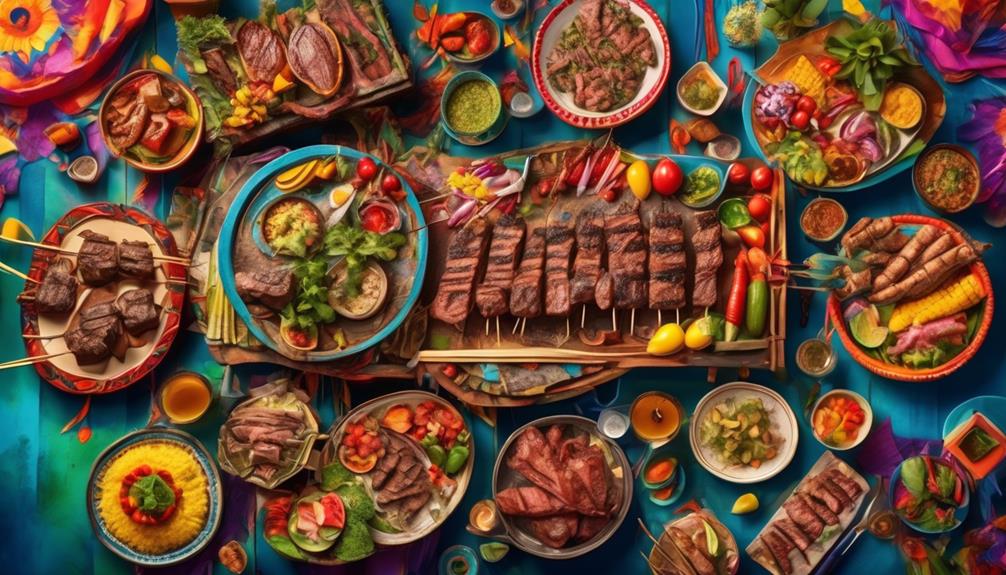
We can't talk about Brazilian cuisine without mentioning the mouthwatering tradition of churrasco, or Brazilian barbecue.
The churrasco experience is all about the variety of grilled meats, from succulent beef to juicy pork and flavorful sausages, all cooked to perfection over open flames.
This centuries-old cooking method has deep cultural roots and brings together friends and family to savor the rich, traditional barbecue flavors that are a cornerstone of Brazilian culinary heritage.
Grilled Meat Variety
Nestled within the vibrant culture of Brazil, the Churrasco, a tantalizing Brazilian barbecue, offers a sizzling array of grilled meat delights that have been a cornerstone of the country's culinary heritage for generations.
The Churrasco tradition involves expertly grilling various meats to perfection, creating a symphony of flavors and textures that captivate the senses. Here are some highlights of the grilled meat variety:
- Picanha: This prime cut of beef, often seasoned with rock salt, is a churrasco classic, renowned for its succulent juiciness.
- Frango com Bacon: Chicken wrapped in bacon showcases the artistry of churrasco, blending tender poultry with savory, smoky flavors.
- Costela de Porco: Slow-grilled pork ribs, marinated in a medley of spices, offer a rich and tender taste experience.
- Cordeiro: Lamb, expertly seasoned and grilled, provides a delectable and distinctive addition to the churrasco repertoire.
Traditional Barbecue Flavors
Immersed in the Brazilian culinary tradition, Churrasco's traditional barbecue flavors entice with a symphony of sizzling meats, each expertly seasoned and grilled to perfection, embodying the rich heritage and vibrant flavors of Brazil. The heart of Churrasco lies in its traditional marinades, where cuts of meat are lovingly bathed in a mixture of garlic, lime, and fresh herbs, allowing the flavors to meld and infuse. These marinades have been passed down through generations, each family adding its unique touch. The barbecue techniques, often involving slow roasting over open flames, result in tender, juicy meats bursting with smoky, charred goodness. Asados, or barbecue gatherings, are a cornerstone of Brazilian social life, where friends and family come together to celebrate, share stories, and savor the mouthwatering fruits of the grill.
| Traditional Marinades | Barbecue Techniques | Cultural Significance |
|---|---|---|
| Garlic, lime, herbs | Slow roasting | Social celebrations |
Quindim: Irresistible Coconut Custard
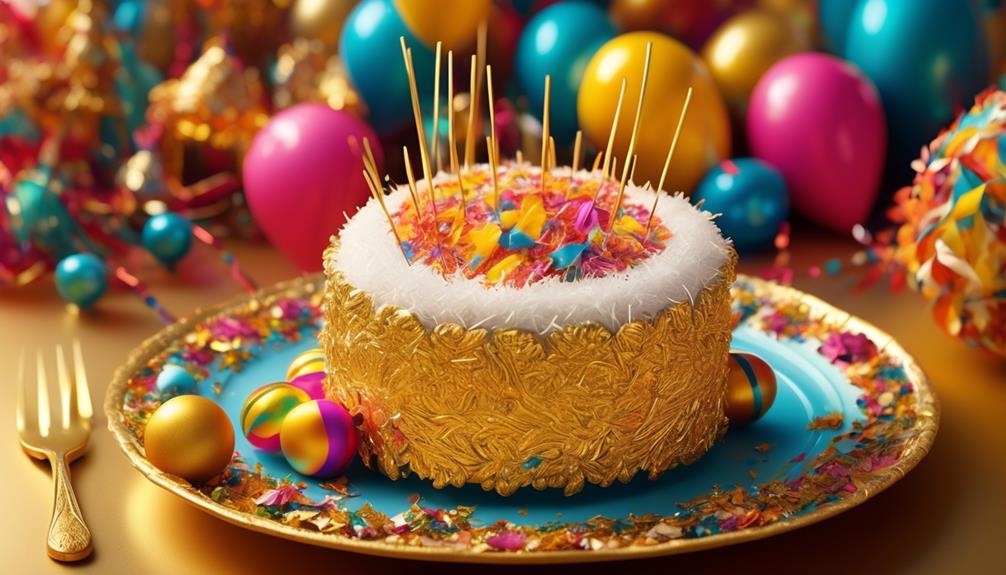
As you explore the vibrant streets of Brazil during carnival season, the aroma of freshly baked quindim tantalizes your senses, a delectable coconut custard treat that's a beloved tradition in Brazilian cuisine. Quindim, with its golden hue and luscious, sweet flavor, holds a special place in the hearts of Brazilians. Here are four essential aspects of this irresistible coconut custard:
- Cultural Significance: Quindim has its roots in Afro-Brazilian culture, with the coconut being a staple ingredient in many traditional desserts. Its creation is intertwined with the country's history, reflecting the influence of African culinary traditions on Brazilian cuisine.
- Historical Origins: This delightful dessert has been enjoyed for generations, with its precise origins dating back to the colonial era. Its evolution over time mirrors the complex tapestry of Brazilian history, making it a symbol of cultural heritage.
- Ingredient Harmony: The simplicity of quindim's ingredients – coconut, eggs, and sugar – harmonizes to create a rich, velvety texture that delights the palate. The tropical essence of coconut shines through, capturing the essence of Brazil's lush landscapes.
- Celebratory Treat: During Carnival, quindim takes center stage as a popular sweet indulgence, adding a touch of decadence to the festivities. Its presence at celebratory gatherings underscores its significance in Brazilian culinary traditions.
The allure of quindim lies not only in its delicious taste but also in its cultural and historical significance, making it an essential part of the Brazilian culinary experience.
Pastel: Crispy Fried Pastries With Various Fillings

Crispy fried pastries known as pastel have been a beloved part of Brazilian street food culture for generations, offering a delightful array of fillings that showcase the rich and diverse flavors of the country. These golden, crispy pastries are typically filled with a variety of savory or sweet ingredients, providing a burst of flavor in every bite. From traditional meat and cheese fillings to more exotic combinations like shrimp and heart of palm, pastel reflects the cultural melting pot of Brazil. Brazilians take great pride in their pastel fillings, often passing down secret family recipes to create unique and unforgettable flavor combinations. Whether enjoyed as a quick snack during Carnival festivities or as a leisurely meal, pastel is a staple of Brazilian cuisine that continues to captivate locals and visitors alike.
| Savory Fillings | Sweet Fillings |
|---|---|
| Ground Beef | Guava and Cheese |
| Chicken and Catupiry Cheese | Chocolate and Banana |
| Cheese and Ham | Doce de Leite |
As an alternative to the traditional fried pastel, some vendors offer baked versions, providing a healthier option without compromising the delicious flavors. These crispy pastel alternatives have gained popularity, catering to the evolving tastes and dietary preferences of consumers while maintaining the essence of this beloved Brazilian treat.
Tapioca Crepes: Versatile and Delicious Street Food
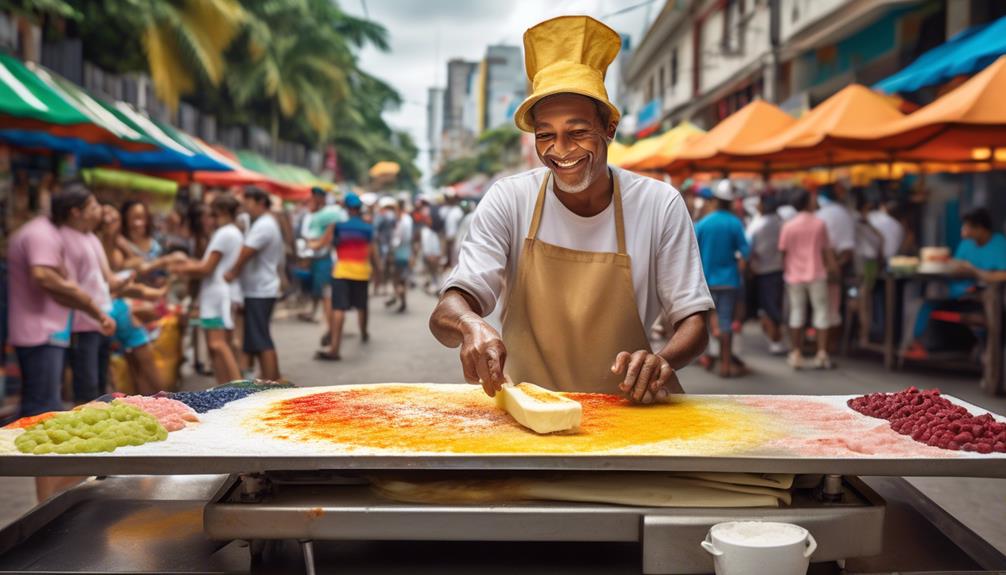
Tapioca crepes, a beloved street food in Brazil, offer a versatile and delicious culinary experience, reflecting the rich cultural heritage and diverse flavors of the country. These delicate crepes, made from cassava flour, are a staple of Brazilian cuisine, enjoyed by locals and tourists alike during festive occasions like Carnival.
Here's what makes tapioca crepes a must-try street food:
- Versatile filling: Tapioca crepes can be filled with an array of savory or sweet ingredients, catering to diverse palates. From cheese, ham, and shredded chicken to chocolate, coconut, and condensed milk, the filling options are endless.
- Delicious toppings: Once the crepe is filled, it's folded and cooked until crispy on the outside and gooey on the inside. It's then topped with various ingredients such as fresh fruits, Nutella, or even savory toppings like butter or herbs, adding an extra layer of flavor.
- Cultural significance: Tapioca crepes have roots in indigenous Brazilian cuisine, dating back centuries. Their enduring popularity reflects the blending of cultural influences in the country's culinary landscape.
- Street food tradition: These crepes are often prepared and sold by vendors in bustling street markets and squares, adding to the lively and vibrant atmosphere of Brazilian festivities.
Açaí Bowls: Energizing and Nutritious Treats

How do energizing and nutritious açaí bowls reflect the cultural heritage and culinary traditions of Brazil?
Açaí bowls have become an integral part of Brazilian cuisine, embodying the fusion of indigenous traditions and modern health consciousness. The health benefits of açaí berries are vast, containing antioxidants, healthy fats, and fiber that promote overall well-being.
As a reflection of the Brazilian culinary ethos, açaí bowls often incorporate local ingredients like granola, fresh fruits such as bananas and strawberries, and sweeteners like honey or condensed milk. This combination of flavors creates a delightful contrast between the creamy, earthy richness of the açaí and the crisp, tangy sweetness of the fruits and granola.
The açaí bowl has deep cultural roots in the Amazon region, where the açaí palm grows abundantly. Indigenous communities have long revered the açaí berry for its nourishing properties, incorporating it into their diets and traditional medicine. Over time, açaí bowls have evolved into a symbol of vitality and a source of sustenance during festive occasions like Carnival.
This enduring tradition highlights the enduring connection between food, culture, and celebration in Brazil.
Caipirinha: Brazil's Classic Lime Cocktail
Derived from Brazil's rich culinary heritage, the classic lime cocktail, Caipirinha, holds a significant place in the country's cultural celebrations and social gatherings. This iconic drink is deeply rooted in the cocktail culture of Brazil, reflecting the country's history and traditions.
Here are some interesting aspects to consider:
- Caipirinha Variations: The traditional Caipirinha is made with cachaça, lime, sugar, and ice. However, there are numerous variations of this classic cocktail, such as using different fruits like passion fruit or pineapple, which add a unique twist to the original recipe.
- Cocktail Culture: In Brazil, the art of crafting and enjoying cocktails is a cherished part of the social fabric. The preparation of Caipirinha is often a communal activity, where friends and family come together to share stories and celebrate life.
- Caipirinha Pairing: This refreshing cocktail pairs exceptionally well with traditional Brazilian dishes like feijoada, a black bean stew, or seafood moqueca. The zesty and citrusy flavors of Caipirinha complement the rich and savory flavors of these dishes.
- Drink Recipes: While the classic Caipirinha remains a favorite, mixologists and bartenders are constantly innovating, creating new recipes and variations to elevate the drinking experience. These recipes often incorporate local Brazilian ingredients, adding depth and complexity to the cocktail.
Frequently Asked Questions
What Are the Traditional Drinks That People Consume During Carnival in Brazil?
During Carnival in Brazil, we relish traditional cocktails that hold deep cultural significance.
One of the most popular alternatives is the Caipirinha, made with cachaça, lime, and sugar. It's a refreshing and iconic drink that captures the spirit of the festivities.
Another beloved option is the Batida, a creamy and tropical blend of cachaça, coconut milk, and fruit. These drinks are cherished for their historical and social importance during this vibrant celebration.
Are There Any Specific Desserts That Are Commonly Enjoyed During Carnival in Brazil?
Do people eat specific desserts during Carnival in Brazil? Absolutely! Carnival desserts hold deep cultural significance, reflecting the country's rich history and diverse influences.
These treats have evolved over time, blending indigenous, European, and African flavors and techniques. From the decadent sweet cakes and pastries to the vibrant fruit-based delights, the variety of Carnival desserts mirrors Brazil's diverse cultural heritage and adds a delightful touch to the festive celebrations.
What Are Some Popular Street Food Options That People Eat During Carnival in Brazil?
During Carnival in Brazil, popular snacks like coxinha, pastel, and acarajé are enjoyed. Culinary influences from African, Portuguese, and indigenous cultures are evident in these street food options.
Street vendors offer a variety of savory and sweet treats, creating a vibrant and festive atmosphere.
The historical perspective of these foods reflects the diverse cultural heritage of Brazil, making Carnival a delicious celebration of tradition and community.
Are There Any Regional Variations in the Food That Is Consumed During Carnival in Brazil?
Regional variations in the food consumed during Carnival in Brazil are significant. Each region showcases unique food traditions, influenced by historical and cultural factors. The diversity in culinary offerings reflects the country's rich heritage, from African, European, and indigenous influences.
This creates a vibrant tapestry of flavors and dishes, adding to the overall cultural significance of the festival. These regional variations contribute to the dynamic and colorful tapestry of Brazilian cuisine during Carnival.
How Do People Typically Prepare and Cook the Traditional Dishes Eaten During Carnival in Brazil?
When preparing and cooking traditional dishes eaten during Carnival in Brazil, we employ a range of preparation techniques and cooking methods to ensure the flavors are rich and the textures are just right.
From marinating meats for feijoada to slow-cooking stews for hours, the attention to detail in our culinary traditions is unparalleled.
Each step in the preparation and cooking process is infused with cultural context and historical significance, making the experience truly immersive.
Conclusion
As the sun sets on the vibrant streets of Brazil during carnival, the air is filled with the tantalizing aromas of feijoada, coxinha, and acarajé.
The sizzle of pastel frying in hot oil and the sweet sound of tapioca crepes being flipped on griddles create a symphony of flavors and textures.
The joy and energy of the carnival are perfectly complemented by the delicious and diverse traditional foods that bring people together in celebration.
- About the Author
- Latest Posts
Introducing Ron, the home decor aficionado at ByRetreat, whose passion for creating beautiful and inviting spaces is at the heart of his work. With his deep knowledge of home decor and his innate sense of style, Ron brings a wealth of expertise and a keen eye for detail to the ByRetreat team.
Ron’s love for home decor goes beyond aesthetics; he understands that our surroundings play a significant role in our overall well-being and productivity. With this in mind, Ron is dedicated to transforming remote workspaces into havens of comfort, functionality, and beauty.
Carnival Decoration
Why Is Bunting Called Bunting?

Have you ever thought about why bunting is named bunting?
It's like peeling back the layers of a mysterious package, each layer revealing a little more about its origins and cultural significance. The evolution of its name is a fascinating journey that takes us through different languages and historical contexts.
But there's more to it than just etymology; bunting holds a unique place in various cultures and has a modern appeal that continues to captivate.
So, let's unravel the mystery and discover the intriguing story behind why bunting is called bunting.
Key Takeaways
- The word 'bunting' originated from the Old French word 'bontin' and was initially used for maritime flag communication.
- Over time, 'bunting' evolved into festive decorations for land-based celebrations.
- Bunting is deeply ingrained in traditional celebrations worldwide and symbolizes unity, patriotism, and celebration.
- Bunting is a versatile decorative element that adds nostalgia and whimsy to events and settings.
Origins of Bunting

The origins of bunting can be traced back to ancient civilizations, where evidence of this decorative practice has been found in archaeological discoveries. The etymology of the word 'bunting' is thought to have originated from the Old French word 'bontin,' meaning 'colorful' or 'painted canvas.'
Historical origins suggest that bunting was initially used as a form of maritime flag communication, with colorful flags being used to send messages between ships. Over time, this practice extended to land-based celebrations and decorations, evolving into the festive bunting we recognize today.
In ancient times, bunting was made from various materials such as cotton, wool, and even silk, and was often adorned with intricate designs and patterns. The use of bunting as a decorative element became widespread during the 17th and 18th centuries, particularly in Europe and the United States, where it was used to embellish public spaces during festive occasions and celebrations.
Understanding the historical roots of bunting provides insight into its cultural significance and enduring appeal as a decorative art form.
Evolution of Bunting's Name

Tracing the etymology of the word 'bunting' leads us to the Old French term 'bontin,' which originally denoted 'colorful' or 'painted canvas,' providing insight into the evolution of bunting's name. Over time, the term 'bontin' transitioned into 'buntine' in Middle English, referring to a lightweight open fabric used for sieves or nets. This transformation reflects the evolving use of the material, shifting from decorative purposes to more functional applications.
As the English language continued to develop, 'buntine' gradually transformed into 'bunting,' expanding its meaning to encompass various types of loosely woven fabrics, particularly those used for flags and festive decorations. The semantic shift from a specific type of fabric to a broader category reflects the linguistic evolution of the term. This evolution demonstrates how language adapts to accommodate changes in material use and cultural practices.
Understanding the evolution of bunting's name provides valuable insights into the historical contexts in which the term was used and the cultural significance attached to it. Etymological analysis allows us to trace the trajectory of bunting's name, highlighting its journey from a colorful canvas to a diverse category of loosely woven fabrics.
Cultural Significance of Bunting
Exploring the cultural significance of bunting sheds light on its historical and symbolic resonance within various societal contexts. Bunting, with its origins as a maritime signal and festive decoration, has become deeply ingrained in traditional celebrations and symbolic decorations across the world. Its presence in cultural and historical events has made it an enduring symbol of unity, celebration, and national pride.
| Traditional Celebrations | Symbolic Decorations |
|---|---|
| Bunting is often used in traditional celebrations such as national holidays, weddings, and festivals, where it adorns streets, buildings, and parade floats, adding to the festive atmosphere. | As a symbolic decoration, bunting signifies unity, patriotism, and celebration. It is often used to represent national colors, bringing a sense of pride and identity to public spaces and events. |
This enduring tradition of using bunting for decorative and symbolic purposes has made it a beloved and recognizable feature in cultural celebrations. As societies continue to evolve, bunting remains a timeless emblem of joy and unity, connecting people across generations and cultures in moments of celebration and national pride.
Bunting in Different Languages
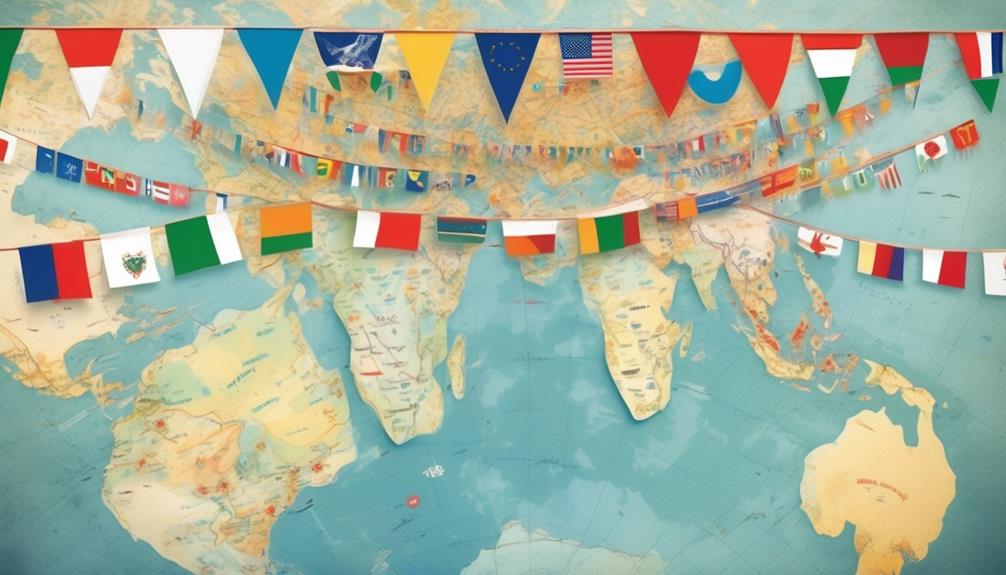
In understanding the cultural significance of bunting, it becomes apparent that its presence isn't confined to a single language, as its use and symbolism extend across various linguistic traditions.
Language variations in the use of bunting reveal its historical context and diverse cultural interpretations. In English, the term 'bunting' originally referred to the lightweight woolen cloth used for making flags, and its usage later extended to decorative flags and streamers.
In Spanish, 'banderines' or 'guirnaldas' are terms used for decorative bunting, reflecting the rich tradition of vibrant fiestas and celebrations in Hispanic cultures.
The French refer to bunting as 'fanions' or 'guirlandes,' reflecting their historical use in military and festive contexts.
German and Dutch languages use 'Wimpel' and 'vlaggetjes' respectively to denote bunting, reflecting the cultural significance of decorative flags in these societies.
These language variations highlight the historical context of bunting as a universal symbol of celebration, festivity, and cultural identity, transcending linguistic boundaries.
The Modern Appeal of Bunting
The modern appeal of bunting lies in its versatile use as a decorative element that adds a touch of nostalgia and whimsy to various events and settings. In today's context, bunting has found a place in modern aesthetics, offering a charming and elegant way to enhance the visual appeal of spaces. Its ability to evoke a sense of nostalgia while still feeling fresh and contemporary has contributed to its enduring popularity.
Creative applications of bunting have expanded its appeal, making it a staple in events ranging from intimate gatherings to large-scale festivals. Its ability to transform ordinary spaces into enchanting settings has made it a favorite among event planners and individuals alike. The creative use of colors, patterns, and materials has allowed bunting to adapt to a wide range of themes and styles, from rustic and vintage to modern and eclectic.
Moreover, its association with traditional celebrations and outdoor events has contributed to its modern appeal, as it brings a sense of warmth and conviviality to any setting. The enduring charm of bunting lies in its ability to infuse spaces with a sense of joy and celebration, making it a beloved decorative element in the contemporary world.
Frequently Asked Questions
What Are the Different Types of Materials Used to Make Bunting?
Types of materials used to make bunting include fabric, plastic, paper, and felt. These materials offer versatility for creative applications, such as outdoor decorations, party decor, and festive events.
Additionally, bunting materials can be repurposed for alternative uses, such as crafting and DIY projects. Each material brings unique qualities to bunting, allowing for diverse customization and visual appeal in various settings.
Is Bunting Only Used for Decorative Purposes, or Does It Have Other Practical Uses?
Practical uses of bunting extend beyond mere decoration. Its versatility makes it ideal for creative applications. Although often associated with festive occasions, bunting has practical uses in maritime signaling, aviation, and even military contexts.
Its vibrant colors and eye-catching design also make it a valuable tool for advertising and safety markings. The historical evolution of bunting's practical applications showcases its enduring significance in various fields.
Are There Any Specific Traditions or Customs Associated With the Use of Bunting in Different Cultures?
In different cultures, bunting carries significant cultural significance and is often intertwined with historical origins. Various traditions and customs are associated with its use, reflecting the diverse ways it's utilized for celebrations and events.
The historical origins of bunting reveal its evolution and continued relevance in different cultural contexts, shedding light on its enduring importance. Understanding these traditions and historical connections provides insight into the rich tapestry of meanings associated with bunting.
How Has the Popularity of Bunting Changed Over Time?
The evolution of bunting's popularity has been fascinating. Over time, it has transitioned from a traditional decorative element to a symbol of celebration and festivity.
The cultural significance of bunting has grown, becoming a ubiquitous feature at events and gatherings. Its colorful and cheerful nature has made it a beloved adornment, reflecting the joyous spirit of various occasions.
This shift in perception has contributed to the enduring appeal of bunting across different cultures.
Are There Any Superstitions or Beliefs Surrounding the Use of Bunting in Certain Cultures?
Superstitions and cultural significance surrounding bunting vary widely across different cultures. In some societies, bunting is believed to bring good luck and ward off evil spirits when displayed during celebrations and festivals.
Conversely, in other traditions, there are superstitions associated with the colors and patterns of bunting, with specific combinations believed to attract prosperity or protect against misfortune.
Understanding these beliefs adds depth to the history and use of bunting in diverse cultures.
Is There a Cultural Significance Behind the Name “Bunting” and the Tradition of Cake Smashing?
The tradition of cake smashing has become a popular trend in recent years, with many couples incorporating it into their wedding festivities. While the reasons for cake smashing vary, it is often seen as a fun and lighthearted way to celebrate the joy of marriage. As for the cultural significance behind the name “Bunting”, it is often associated with festive and celebratory occasions, making it a fitting choice for a wedding tradition like cake smashing.
Conclusion
In tracing the origins of bunting and its name, we've uncovered a rich history of cultural significance and evolution. From its humble beginnings to its modern appeal, bunting has woven itself into the fabric of our lives.
Its colorful presence brings joy and celebration, like a fluttering array of flags in the wind, symbolizing unity and festivity across different cultures and languages.
The name 'bunting' may have a simple origin, but its impact is profound and enduring.
- About the Author
- Latest Posts
Introducing Ron, the home decor aficionado at ByRetreat, whose passion for creating beautiful and inviting spaces is at the heart of his work. With his deep knowledge of home decor and his innate sense of style, Ron brings a wealth of expertise and a keen eye for detail to the ByRetreat team.
Ron’s love for home decor goes beyond aesthetics; he understands that our surroundings play a significant role in our overall well-being and productivity. With this in mind, Ron is dedicated to transforming remote workspaces into havens of comfort, functionality, and beauty.
Carnival Decoration
Best Cruises From San Francisco

As we explore the numerous cruise choices leaving from San Francisco, it is interesting to observe that the city’s cruise terminal experienced a 9% rise in passenger traffic last year. With a wide variety of destinations and experiences available, it is no surprise that San Francisco has become a vibrant center for cruise enthusiasts.
But before we set sail into the details of the best cruises from this iconic port, let's take a moment to consider the unique allure of embarking on a voyage from the City by the Bay.
Key Takeaways
- San Francisco cruise terminal experienced a 9% increase in passenger traffic last year.
- The Alaskan adventure cruise offers wildlife encounters and glacial exploration.
- The Hawaiian Paradise cruise offers island-hopping delights and diverse Hawaiian cuisine.
- The Mexican Riviera cruise offers sun, sand, Mexican cuisine, and captivating cultural experiences.
Alaskan Adventure: Discover the Wild North

Embark on an unforgettable Alaskan adventure and discover the untamed beauty of the Wild North with our exhilarating cruise from San Francisco. As you set sail, be prepared for awe-inspiring wildlife encounters.
The crisp, salty air fills your lungs as you scan the horizon for a glimpse of a breaching humpback whale or a majestic bald eagle soaring overhead. The pristine waters teem with life, offering a chance to witness playful otters and curious seals as they navigate their natural habitat.
Glacial exploration is a cornerstone of our Alaskan adventure. Feel the chill in the air as you approach these ancient rivers of ice. Towering glaciers command attention with their breathtaking beauty and raw power. Witness the spectacle of massive ice calving into the sea, creating a thunderous roar that reverberates through the fjords. Our expert guides provide captivating insights into the geological forces that have shaped this unique landscape over millennia.
With wildlife encounters and glacial exploration awaiting at every turn, our Alaskan adventure promises an enriching and unforgettable experience.
Pacific Coast Escapade: Scenic Coastal Cruises

Meandering along the Pacific Coast, our scenic coastal cruises offer a captivating blend of breathtaking vistas and tranquil seascapes, inviting you to immerse yourself in the natural beauty of the West Coast.
As we sail along this stunning coastline, passengers are treated to unparalleled scenic views of rugged cliffs, pristine beaches, and charming coastal towns. The relaxing atmosphere on board complements the serene surroundings, allowing guests to unwind and fully appreciate the awe-inspiring sights.
From the comfort of the ship, passengers can witness the dramatic beauty of the Pacific Coast unfold before their eyes. The ever-changing scenery, from majestic rock formations to lush forests meeting the sea, creates a picturesque backdrop for a truly unforgettable journey. Our expert crew is dedicated to ensuring that every guest has the opportunity to savor these remarkable views, whether from spacious deck areas or through panoramic windows in the ship's common areas.
With an emphasis on providing an enriching and rejuvenating experience, our scenic coastal cruises are designed for those seeking a deeper connection with nature and a profound appreciation for the wonders of the Pacific Coast. Whether you're a seasoned traveler or embarking on your first cruise, our Pacific Coast escapade promises an unparalleled blend of relaxation and natural beauty.
Hawaiian Paradise: Island-Hopping Delights
As we set sail for the Hawaiian Paradise, prepare to be captivated by the allure of island-hopping delights that await us in the tranquil waters of the Pacific. Our journey through the Hawaiian Islands promises an enchanting blend of tropical beaches and vibrant culture. From the moment we arrive at the first island, the air is filled with the scent of plumeria and the sound of ukuleles, beckoning us to immerse ourselves in the local rhythm.
Each island offers its own unique charm, from the stunning volcanic landscapes of the Big Island to the lush rainforests of Kauai.
Our adventure will take us to Maui, where we can bask in the beauty of the famous Road to Hana, and to Oahu, where we can explore the historic sites of Honolulu and surf the legendary waves of the North Shore. The island-hopping experience allows us to sample the diverse flavors of Hawaiian cuisine, from traditional luau feasts to innovative farm-to-table dining experiences.
With its rich history, breathtaking natural wonders, and warm hospitality, the Hawaiian Paradise is a destination that promises an unforgettable journey through some of the most beautiful islands in the world.
Mexican Riviera Exploration: Sun, Sand, and Culture

Exploring the Hawaiian Paradise has been an unforgettable journey, and now we're thrilled to set our sights on the vibrant Mexican Riviera, where sun, sand, and culture await us for an enriching exploration.
The Mexican Riviera is a treasure trove of experiences, offering breathtaking beach activities, a rich tapestry of local cuisine, traditional dances, and fascinating historical sites.
As we step onto the soft, golden sands, we'll be greeted by the rhythmic beats of traditional music and the aroma of delectable, authentic Mexican dishes. The beaches here are perfect for diving into thrilling water sports or simply lounging under the warm, tropical sun.
Our taste buds will be tantalized by the flavors of freshly caught seafood, zesty salsas, and mouthwatering tacos. Moreover, the Mexican Riviera's captivating culture comes alive through vibrant traditional dances and the opportunity to explore historical sites like the ancient Mayan ruins.
This journey promises to be an immersive experience, where every moment is filled with the colors, flavors, and rhythms of this captivating region.
Transpacific Voyages: Epic Ocean Crossings
Embarking on transpacific voyages offers a thrilling opportunity to experience epic ocean crossings that traverse vast expanses of open water, connecting diverse and captivating destinations. As we prepare to set sail on these extraordinary maritime adventures, we're filled with anticipation for the historical significance and cultural exchange that awaits us.
Here's why transpacific voyages are a must for those seeking international exploration:
- Historical Significance: These voyages trace the routes of ancient explorers, connecting the Pacific Rim and playing a pivotal role in shaping world history.
- Maritime Adventures: From the moment we embark, we're immersed in the legacy of seafaring, experiencing the thrill of navigating the open sea while learning about the rich maritime heritage.
- Cultural Exchange: As we cross the vast Pacific, we anticipate the opportunity to engage with diverse cultures, languages, and traditions, fostering a deep appreciation for global diversity.
- International Exploration: Transpacific voyages open the door to a world of exploration, offering access to remote islands, bustling metropolises, and everything in between, making it an unforgettable journey of discovery.
Prepare to be captivated by the allure of transpacific voyages, where the call of adventure meets the embrace of international discovery.
Frequently Asked Questions
What Are the Onboard Entertainment Options for Families With Young Children on These Cruises?
We offer various onboard entertainment options for families with young children, including childcare facilities and kids clubs. These spaces are designed to provide a safe and engaging environment for kids to have fun while parents enjoy other activities.
Additionally, we offer a wide range of entertainment and activities suitable for all ages, ensuring that the whole family can enjoy their time on the cruise.
Are There Any Special Dining Options or Culinary Experiences Available on These Cruises?
We love the culinary workshops and specialty restaurants on these cruises.
The culinary workshops offer a hands-on experience, teaching us new cooking techniques and recipes.
The specialty restaurants provide a diverse array of gourmet dining options, from fine dining to international cuisines.
It's a delightful way to explore different flavors and indulge in unique culinary experiences while sailing the seas.
What Are the Vaccination and Health Requirements for Passengers on These Cruises?
Vaccination requirements and health screenings are essential for passengers on these cruises. It's crucial to ensure all travelers are up to date with their vaccinations and pass health screenings before boarding.
Additionally, having travel insurance is wise, and knowing the availability of medical facilities on the cruise is important for peace of mind.
These measures contribute to a safe and enjoyable experience for everyone on board.
Can Passengers Bring Their Own Alcohol on Board or Is It Available for Purchase?
Yes, passengers are responsible for adhering to the alcohol policy. Most cruises offer the option to purchase alcohol onboard. However, bringing one's own alcohol is generally not allowed due to safety and security reasons.
The onboard facilities usually include bars and lounges where passengers can purchase a variety of alcoholic beverages. It's important to check with the specific cruise line for their purchasing options and policies regarding alcohol consumption.
Are There Any Specific Packing Tips or Dress Code Recommendations for These Cruises?
When it comes to packing for cruises, it's essential to consider the destination and activities. For warm destinations, lightweight clothing, bathing suits, and sunscreen are must-haves.
For cooler climates, layers and a waterproof jacket are essential.
As for dress codes, most cruises have formal nights, so packing a cocktail dress or suit is a good idea. Check the specific cruise line's guidelines to ensure you're prepared for all occasions.
Are There Any Cruises From San Francisco That Cater to 18 Year Olds?
Yes, there are best cruise options for teens from San Francisco. Many cruise lines offer sailings that cater to 18-year-olds with activities, entertainment, and excursions suitable for young adults. From adventurous activities to vibrant nightlife, these cruises provide a great mix of fun for 18-year-olds.
Conclusion
We hope you've enjoyed learning about the best cruises from San Francisco.
Did you know that the Port of San Francisco saw a 10% increase in cruise ship passengers in 2019?
With so many incredible destinations to choose from, there's no better time to set sail from the City by the Bay and embark on an unforgettable adventure at sea.
Happy cruising!
- About the Author
- Latest Posts
Introducing Ron, the home decor aficionado at ByRetreat, whose passion for creating beautiful and inviting spaces is at the heart of his work. With his deep knowledge of home decor and his innate sense of style, Ron brings a wealth of expertise and a keen eye for detail to the ByRetreat team.
Ron’s love for home decor goes beyond aesthetics; he understands that our surroundings play a significant role in our overall well-being and productivity. With this in mind, Ron is dedicated to transforming remote workspaces into havens of comfort, functionality, and beauty.
Carnival Decoration
Best Drinks to Order on a Plane

When it comes to flying, the experience can greatly differ depending on various factors. One thing that can definitely impact the journey is the selection of beverages offered on the plane.
Whether you're a seasoned traveler or a first-time flyer, knowing the best drinks to order on a plane can enhance your in-flight experience. From classic cocktails to specialty in-flight creations, the options can be surprisingly diverse. But how do you know which ones to choose?
We'll explore a range of beverage choices that can elevate your time in the air and leave you feeling refreshed upon arrival.
Key Takeaways
- The Old Fashioned is a popular choice among travelers and remains a steadfast favorite on planes.
- Wine selections such as Chateau Montelena Chardonnay, Domaine Serene Pinot Noir, and Veuve Clicquot Champagne offer diverse options to enhance in-flight meals.
- Craft brews and local options, including IPA, Stout or Porter, and Wheat Beer, elevate the beer experience with regional flavors.
- Offering a diverse selection of non-alcoholic beverages, including fruit juices, soft drinks, and bottled water, caters to passengers' preferences and keeps them hydrated during the flight.
Classic Cocktails
When we board a plane, our go-to classic cocktail is often the timeless and sophisticated Old Fashioned. This iconic drink has stood the test of time and continues to be a favorite for many travelers. The mixology secrets behind a perfect Old Fashioned lie in the careful balance of bourbon or rye whiskey, a sugar cube, aromatic bitters, and a twist of orange zest.
Craft cocktail trends may come and go, but the Old Fashioned remains a steadfast choice for those seeking a refined and timeless drink.
As mixology continues to evolve, classic cocktails like the Old Fashioned have seen a resurgence in popularity. Bartenders are rediscovering the art of crafting these traditional drinks, often incorporating small tweaks to elevate the flavors. Whether it's using a particular type of bitters or experimenting with different types of sugars, there's a renewed appreciation for the nuances of classic cocktail recipes.
The next time we find ourselves on a plane, we can confidently order an Old Fashioned, knowing that we're sipping on a drink that embodies mixology secrets and reflects the enduring charm of craft cocktail trends.
Wine Selections

As we explore the wine selections, our journey from classic cocktails like the Old Fashioned leads us to a new realm of delightful and diverse flavors awaiting discovery. When it comes to wine pairings, knowing the vineyard selections can elevate the in-flight experience. Here are some recommended vineyard selections to savor on your next flight:
| Vineyard | Wine | Pairing Suggestions |
|---|---|---|
| Chateau Montelena | Chardonnay | Pair with chicken or pasta dishes. |
| Domaine Serene | Pinot Noir | Perfect with salmon or mushroom-based dishes. |
| Veuve Clicquot | Champagne | Complements salty snacks or seafood. |
These vineyard selections offer a range of flavors to enhance your in-flight meal. From the rich and buttery notes of Chateau Montelena's Chardonnay to the elegant and aromatic Domaine Serene Pinot Noir, there is a wine to suit every palate. And for those looking to add a touch of luxury to their journey, Veuve Clicquot Champagne is an excellent choice, with its crisp effervescence and versatility in pairing with various in-flight snacks. So, sit back, relax, and enjoy the exquisite vineyard selections as you soar through the sky.
Beer and Ale Options
Let's explore the enticing array of beer and ale options available for an enjoyable in-flight experience. When it comes to beer, craft brews and local options can elevate your taste buds while cruising at 30,000 feet. Here are three top picks to consider:
- IPA (India Pale Ale): Known for its bold hop flavor and higher alcohol content, IPAs are a popular choice among beer enthusiasts. Look for local breweries offering their take on this classic style, providing a unique and flavorful experience.
- Stout or Porter: If you prefer a darker, richer brew, stouts and porters are excellent choices. These beers often have notes of coffee, chocolate, or caramel, making them a delightful option for sipping during a flight.
- Wheat Beer: For a lighter and more refreshing option, consider a wheat beer. Brewed with a significant proportion of wheat, this style often offers a crisp and slightly fruity taste, perfect for quenching your thirst while in the air.
Craft brews and local options are fantastic ways to explore the regional beer scene, even when you're thousands of feet above the ground. Cheers to a great in-flight beer selection!
Non-Alcoholic Beverages

We always make sure to offer a diverse selection of non-alcoholic beverages for our passengers to enjoy during their flight.
Staying refreshed and hydrated is essential, so we provide a range of options to cater to different preferences.
For those seeking refreshing options, we offer a variety of fruit juices, including orange, apple, and cranberry, to quench your thirst.
Additionally, our assortment of soft drinks, such as cola, lemon-lime soda, and ginger ale, provides fizzy and flavorful hydration choices.
We also understand the importance of staying healthy while traveling, which is why we offer bottled water and sparkling water to keep you feeling revitalized throughout your journey.
Our goal is to ensure that every passenger has access to their preferred non-alcoholic beverage, whether it's a classic choice or something new to discover.
Specialty In-Flight Creations
Keeping our passengers' refreshment in mind, we also offer a selection of specialty in-flight creations to elevate their travel experience. Our aim is to provide an exceptional and diverse range of beverages that cater to every taste.
Here are three of our most sought-after specialty in-flight creations:
- Signature Mocktails: Our expert mixologists have crafted a selection of refreshing and alcohol-free mocktails that are designed to tantalize the taste buds. From zesty citrus blends to fruit-infused fusions, our signature mocktails offer a delightful alternative for passengers who prefer non-alcoholic options.
- Unique Coffee Blends: We understand the importance of a good cup of coffee, especially during long flights. That's why we take pride in offering unique coffee blends that are specially curated for the in-flight experience. Whether you prefer a rich and bold espresso or a smooth and creamy latte, our specialty coffee blends are sure to satisfy the most discerning coffee connoisseurs.
- Custom Infusions: To cater to the evolving preferences of our passengers, we also offer custom infusions that combine fresh ingredients with innovative flavors. From herbal tea infusions to artisanal fruit-infused water, our custom creations are perfect for those seeking a distinctive and memorable in-flight beverage experience.
Frequently Asked Questions
Can I Bring My Own Alcohol on the Plane?
Sure, you can bring your own alcohol on the plane, but there are some regulations to consider.
Airport security has specific rules about the amount and type of alcohol you can bring.
Also, keep in mind that you may not be allowed to mix your own drinks on the plane, so it's best to check with the airline beforehand.
It's always a good idea to review the regulations before packing any beverages for your flight.
Are There Any Special Cocktail Options for Passengers With Dietary Restrictions or Preferences?
When it comes to special cocktail options for passengers with dietary restrictions or preferences, mocktail alternatives can be a great choice. These delicious non-alcoholic options cater to a variety of tastes and dietary needs, making them a fantastic option for those looking for a unique and refreshing drink while on a flight.
Whether it's a specific dietary requirement or a personal preference, mocktails offer a tasty and satisfying alternative to traditional cocktails.
Do Airlines Offer Any Local or Regional Beer Options?
Local brews and regional favorites are often available on flights, offering a taste of the destination. Craft beer options vary by airline, and some may even allow bringing alcohol onboard.
For those with dietary restrictions, airlines may offer dietary-friendly cocktails, mocktail options, and the ability to make custom drink requests to suit personal preferences.
It's a great way to enjoy a taste of the local scene while flying.
Are There Any Non-Alcoholic Mocktail Options Available on the Flight?
When it comes to non-alcoholic mocktail options on the flight, there are usually a variety of refreshing choices available.
Airlines often provide a range of non-alcoholic beverage alternatives, including mocktails crafted with fresh fruit juices and flavorful syrups.
These creative and alcohol-free concoctions are perfect for those looking to enjoy a delicious and unique drink while soaring through the skies.
Can Passengers Request a Custom In-Flight Creation Based on Their Personal Preferences?
Absolutely, passengers can request a custom in-flight creation based on their personal preferences. This in-flight mixology experience allows us to craft a unique drink tailored to your tastes.
Whether it's a refreshing mocktail or a classic cocktail, we're here to elevate your flying experience. Just let us know your preferences, and we'll work our magic to create the perfect custom drink for you.
Cheers to personalized inflight beverages!
What are the Best Drinks to Order on a Family-Friendly Cruise?
When it comes to the best family friendly cruises, it’s important to consider the drink options available. Non-alcoholic choices like mocktails, smoothies, and fresh juices are always a hit with kids and adults alike. Some cruise lines even offer special kids’ drink menus with fun and colorful options.
Conclusion
So next time you're flying, be sure to order one of these amazing drinks. Whether it's a classic cocktail, a fine wine, a craft beer, or a refreshing non-alcoholic beverage, we've got you covered.
And don't forget to try one of the specialty in-flight creations for a truly unique experience. With these options, you'll feel like you're sipping on luxury at 30,000 feet.
Cheers to a smooth and enjoyable flight!
- About the Author
- Latest Posts
Introducing Ron, the home decor aficionado at ByRetreat, whose passion for creating beautiful and inviting spaces is at the heart of his work. With his deep knowledge of home decor and his innate sense of style, Ron brings a wealth of expertise and a keen eye for detail to the ByRetreat team.
Ron’s love for home decor goes beyond aesthetics; he understands that our surroundings play a significant role in our overall well-being and productivity. With this in mind, Ron is dedicated to transforming remote workspaces into havens of comfort, functionality, and beauty.
-

 Vetted3 weeks ago
Vetted3 weeks ago15 Best Contact Paper for Kitchen Cabinets to Elevate Your Home Decor
-

 Vetted2 weeks ago
Vetted2 weeks ago15 Best Poe Cameras for Home Security – Reviews & Buying Guide
-

 Vetted4 weeks ago
Vetted4 weeks ago15 Best Leather Restorer Products to Revive Your Furniture and Accessories
-

 Vetted3 weeks ago
Vetted3 weeks ago15 Best Drain Snakes to Unclog Your Pipes Like a Pro
-

 Beginners Guides3 days ago
Beginners Guides3 days agoI Inhaled Vinegar Fumes
-

 Vetted3 weeks ago
Vetted3 weeks ago14 Best Stationery Brands for Your Next Writing Adventure
-

 Beginners Guides2 weeks ago
Beginners Guides2 weeks agoSwinger Porch Light Color
-

 Mardi Gras Decoration3 weeks ago
Mardi Gras Decoration3 weeks agoWhy Does Hobby Lobby Not Do Mardi Gras?

























